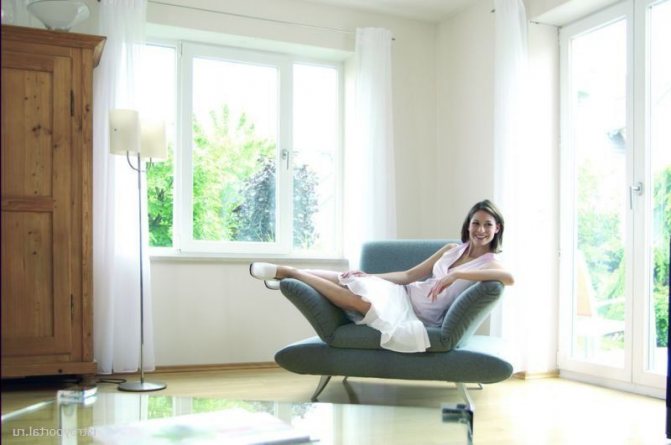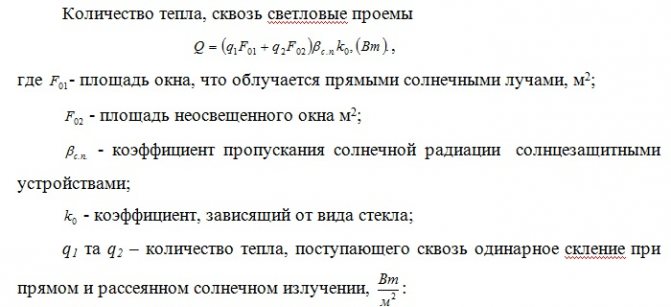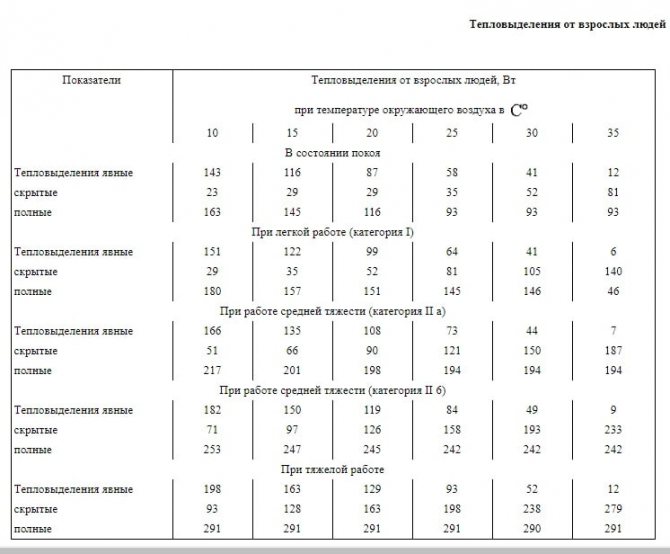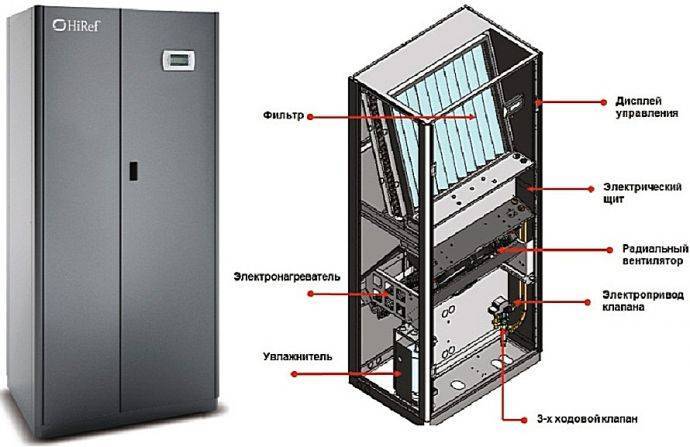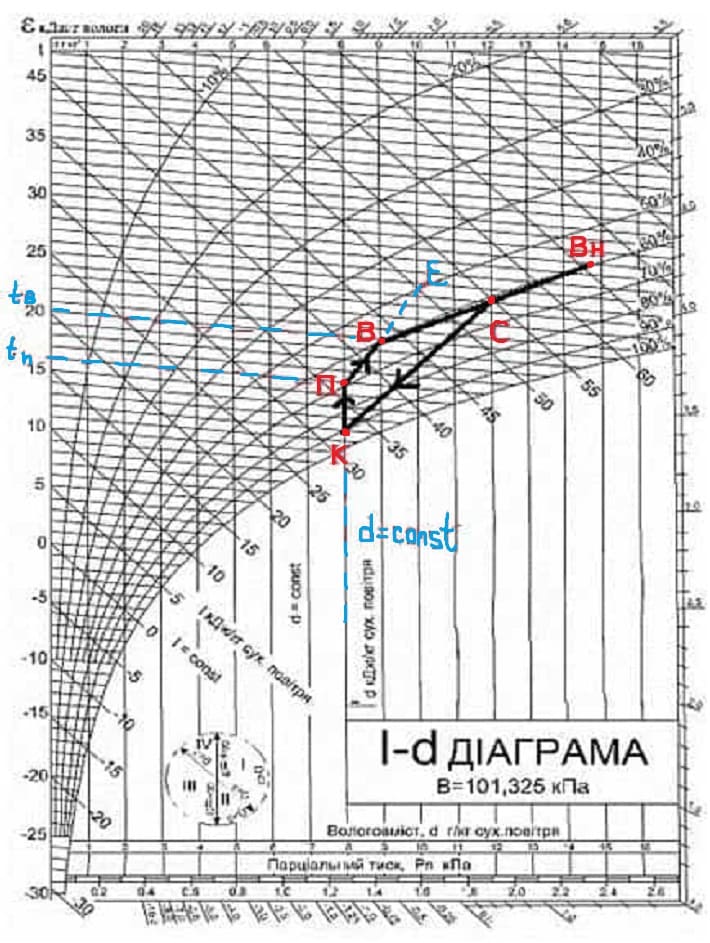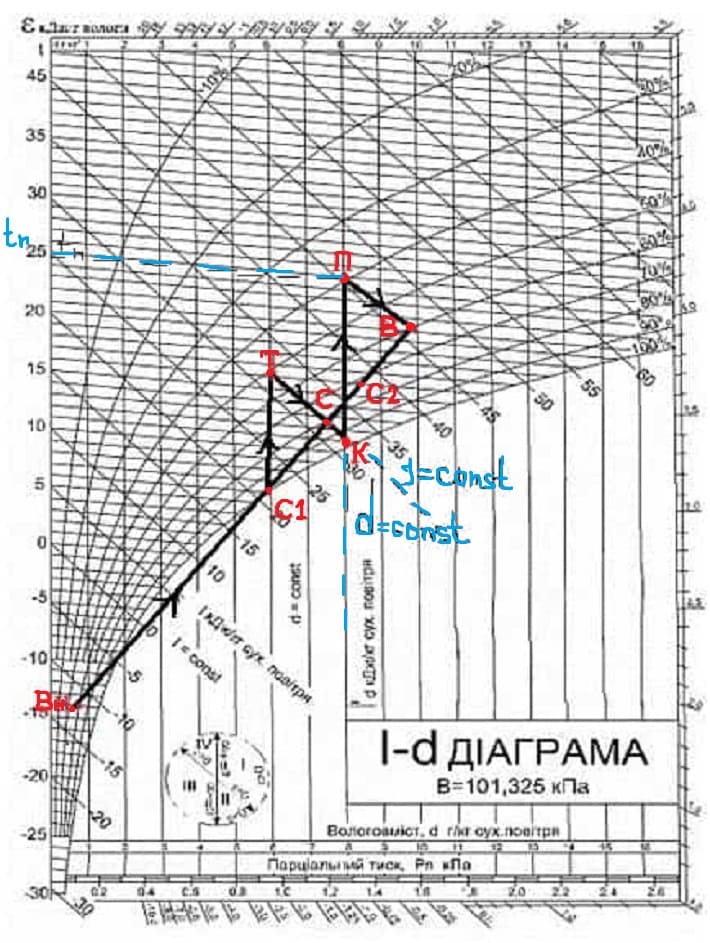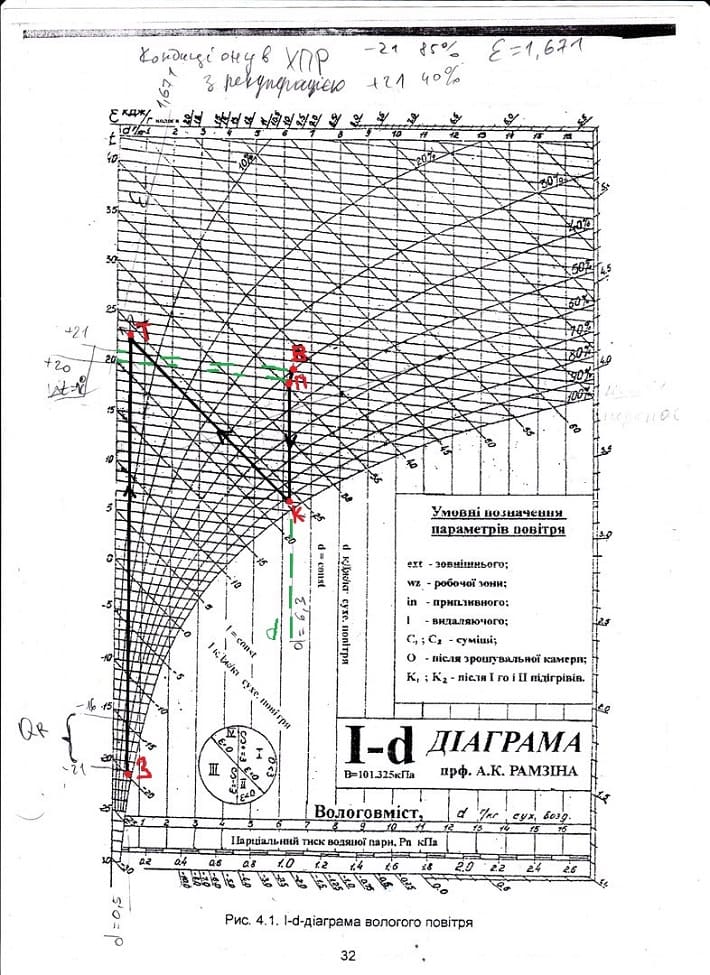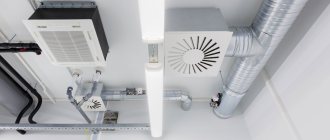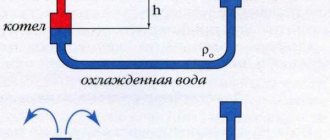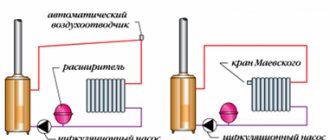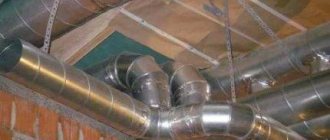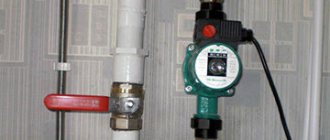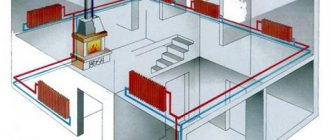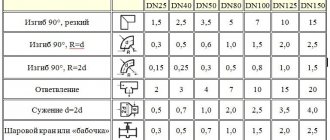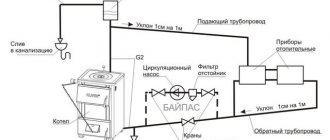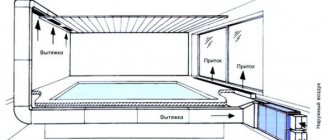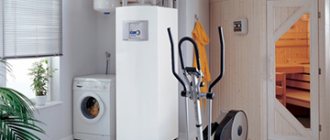Online calculator for calculating cooling capacity
To independently select the power of a home air conditioner, use the simplified method for calculating the area of the refrigerated room, implemented in the calculator. The nuances of the online program and the entered parameters are described below in the instructions.
Note. The program is suitable for calculating the performance of household chillers and split systems installed in small offices. Air conditioning of premises in industrial buildings is a more complex task, solved with the help of specialized software systems or the calculation method of SNiP.
Instructions for using the program
Now we will explain step by step how to calculate the power of the air conditioner on the presented calculator:
- In the first 2 fields, enter the values for the area of the room in square meters and the height of the ceiling.
- Select the degree of illumination (sun exposure) through the window openings. The sunlight penetrating into the room additionally heats the air - this factor must be taken into account.
- In the next drop-down menu, select the number of tenants staying in the room for a long time.
- On the remaining tabs, select the number of TVs and personal computers in the air conditioning zone. During operation, these household appliances also generate heat and are subject to accounting.
- If a refrigerator is installed in the room, enter the value of the electrical power of the household appliance in the penultimate field. The characteristic is easy to learn from the instruction manual of the product.
- The last tab allows you to take into account the supply air entering the cooling zone due to ventilation. According to regulatory documents, the recommended multiplicity for residential premises is 1-1.5.
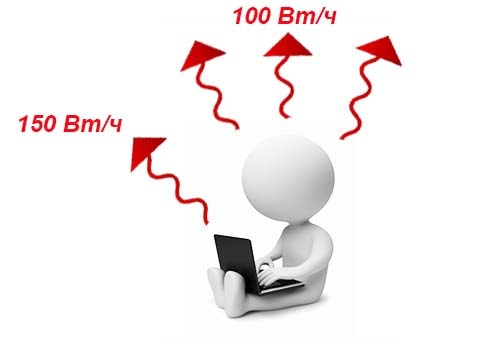
For reference. The air exchange rate shows how many times during one hour the air in the room is completely renewed.
Let's explain some of the nuances of the correct filling of the fields and the selection of tabs. When specifying the number of computers and televisions, consider the simultaneous operation of them. For example, one tenant rarely uses both appliances at the same time.
Accordingly, to determine the required power of the split system, a unit of household appliances that consumes more energy is selected - a computer. The heat dissipation of the TV receiver is not taken into account.
The calculator contains the following values for heat transfer from household appliances:
- TV set - 0.2 kW;
- personal computer - 0.3 kW;
- Since the refrigerator converts about 30% of the consumed electricity into heat, the program includes 1/3 of the entered figure in the calculations.
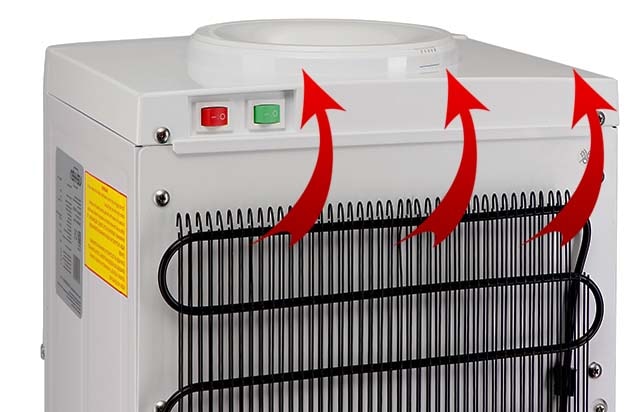

The compressor and radiator of a conventional refrigerator give off heat to the ambient air.
Advice. The heat dissipation of your equipment may differ from the indicated values. Example: the consumption of a gaming computer with a powerful video processor reaches 500-600 W, a laptop - 50-150 W. Knowing the numbers in the program, it is easy to find the necessary values: for a gaming PC, choose 2 standard computers, instead of a laptop, take 1 TV receiver.
The calculator allows you to exclude heat gain from the supply air, but choosing this tab is not entirely correct. Air currents in any case circulate through the dwelling, bringing heat from other rooms, such as the kitchen. It is better to play it safe and include them in the calculation of the air conditioner, so that its performance is sufficient to create a comfortable temperature.
The main power calculation result is measured in kilowatts, the secondary result is in British Thermal Units (BTU). The ratio is as follows: 1 kW ≈ 3412 BTU or 3.412 kBTU.How to choose a split-system based on the obtained figures, read on.
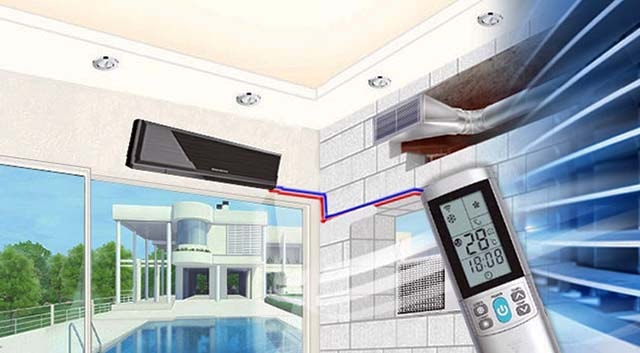

Features of the technique
This technique, which can be used using a heating calculator, is regularly used to calculate the technical and economic efficiency of the implementation of various types of energy-saving programs, as well as during the use of new equipment and the launch of energy-efficient processes.
In order to calculate the heating of the room - the calculation of the heat load (hourly) in the heating system of a separate building, you can use the formula:
In this formula, which calculates the heating of the building:
- a - coefficient showing the possible correction of the difference in temperature of the outside air when calculating the efficiency of the heating system, where to from to = -30 ° C, and the required parameter q is determined;
- Indicator V (m3) in the formula is the external volume of the heated building (it can be found in the design documentation of the building);
- q (kcal / m3 h ° С) is a specific characteristic when heating a building, taking into account to = -30 ° С;
- Ki.р acts as the coefficient of infiltration, which takes into account such additional characteristics as wind strength, heat flow. This indicator indicates the calculation of heating costs - this is the level of heat loss of the building during infiltration, while heat transfer is carried out through an external fence, and the outside air temperature applied to the entire project is taken into account.
In this case, the height is determined to the upper point of the thermal insulation of the attic space. If in a building the roof is combined with an attic floor, then the heating calculation formula uses the building height to the midpoint of the roof. It should be noted that if there are protruding elements and niches in the building, they are not taken into account when calculating the V.
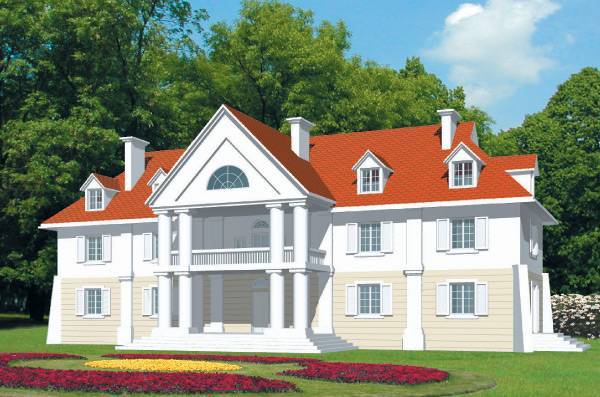

House with protruding niches
After calculating the volume of heating consumption, to determine the area of the basement floor (basement), multiply the area of its horizontal section by the height.
To determine the indicator Ki.r, the following formula is used:
wherein:
- g - acceleration obtained during free fall (m / s2);
- L is the height of the house;
- w - according to SNiP 23-01-99 - the conditional value of the wind speed present in the region during the heating season;
In those regions where the calculated indicator of the outside air temperature t £ -40 is used, when creating a heating system project, before calculating the heating of the room, a heat loss of 5% should be added. This is permissible in cases where it is planned that the house will have an unheated basement. Such heat loss is caused by the fact that the floor of the premises on the 1st floor will always be cold.
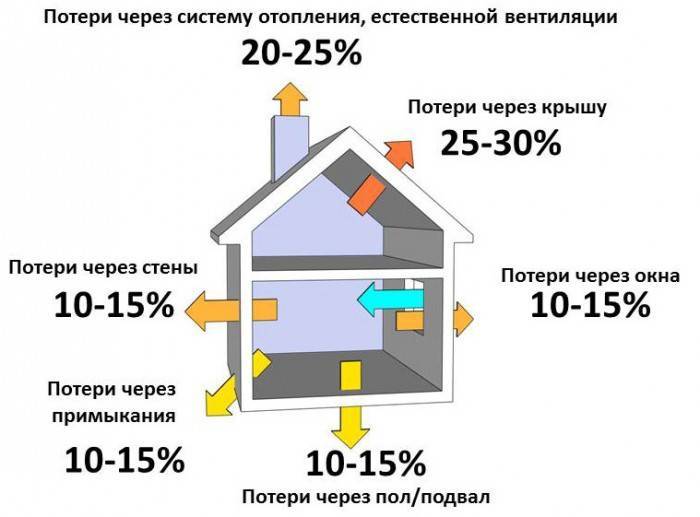

Heat loss at home
For stone houses, the construction of which has already been completed, it is necessary to take into account the higher heat loss in the first heating period and make certain amendments. At the same time, the calculation of heating according to enlarged indicators takes into account the completion date of construction:
May-June - 12%;
July-August - 20%;
September - 25%;
Heating season (October-April) - 30%.
To calculate the specific heating characteristic of a building, q (kcal / m3 h) should be calculated using the following formula:
Calculation method and formulas
On the part of a scrupulous user, it is quite logical not to trust the numbers obtained on an online calculator. To check the result of calculating the power of the unit, use the simplified method proposed by the manufacturers of refrigeration equipment.
So, the required cold performance of a domestic air conditioner is calculated by the formula:


Explanation of designations:
- Qtp is the heat flux entering the room from the street through building structures (walls, floors and ceilings), kW;
- Ql - heat dissipation from apartment tenants, kW;
- Qbp - heat input from household appliances, kW.
It is easy to find out the heat transfer of household electrical appliances - look in the product passport and find the characteristics of the consumed electrical power. Almost all of the consumed energy is converted into heat.
An important point. An exception to the rule is refrigeration units and units operating in start / stop mode. Within 1 hour, the refrigerator compressor will release into the room an amount of heat equal to 1/3 of the maximum consumption specified in the operating instructions.
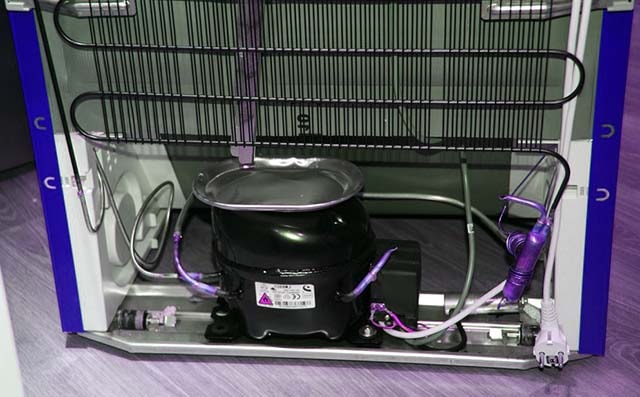

The compressor of a home refrigerator converts almost all of the consumed electricity into heat, but it works in intermittent mode
Heat input from people is determined by regulatory documents:
- 100 W / h from a person at rest;
- 130 W / h - while walking or doing light work;
- 200 W / h - during heavy physical exertion.
For calculations, the first value is taken - 0.1 kW. It remains to determine the amount of heat that penetrates from the outside through the walls by the formula:


- S - the square of the cooled room, m²;
- h is the ceiling height, m;
- q is the specific thermal characteristic referred to the volume of the room, W / m³.
The formula allows you to perform an aggregated calculation of heat flows through the outer fences of a private house or apartment using the specific characteristic q. Its values are accepted as follows:
- The room is located on the shady side of the building, the area of the windows does not exceed 2 m², q = 30 W / m³.
- With an average illumination and glazing area, a specific characteristic of 35 W / m³ is taken.
- The room is located on the sunny side or has many translucent structures, q = 40 W / m³.
Having determined the heat gain from all sources, add the numbers obtained using the first formula. Compare the results of the manual calculation with those of the online calculator.
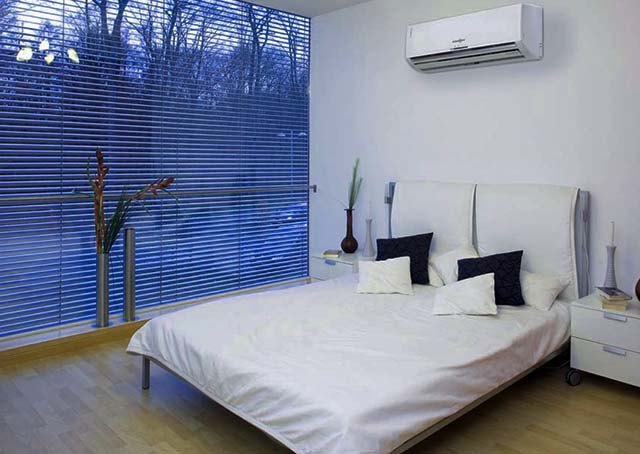

A large glazing area implies an increase in the refrigerating capacity of the air conditioner
When it is necessary to take into account the heat input from the ventilation air, the cooling capacity of the unit increases by 15-30%, depending on the exchange rate. When updating the air environment 1 time per hour, multiply the result of the calculation by a factor of 1.16-1.2.
Power calculation using additional parameters
Under certain circumstances, the value of the required refrigeration power, obtained in a typical calculation, has to be adjusted taking into account some circumstances.
Accounting for the flow of fresh air from a slightly open window
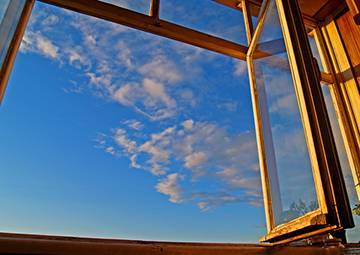

If the user cannot imagine his existence without fresh air and plans to constantly ventilate the room during the operation of the air conditioner, he should increase the Q1 value by 30% in calculating the cooling capacity.
One should not think that an air conditioner, calculated taking into account this amendment, can be operated with windows wide open - a household appliance, even the most powerful one, will not last long under such conditions.
It is understood that the window will only be slightly open (metal-plastic windows - in ventilation mode). Better yet, equip the room with a supply valve, the performance of which can be precisely controlled.
Guaranteed 18 - 20C
The formula for calculating Q1 is based on a 10-degree difference between outdoor and indoor temperatures. It is this difference that is believed to provide sufficient comfort and at the same time is safe: getting into the room from the street, a person does not risk catching a cold.
But some users, even in 40 degrees heat, would like to have 18 - 20 degrees indoors. Then, when calculating, they should increase Q1 by 20% - 30%.
Top floor
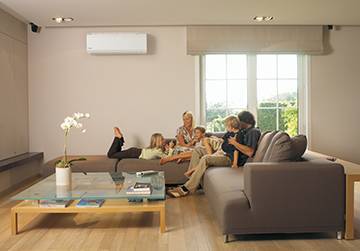

In the apartments of the upper floors, the area of the enclosing structures through which the outside heat penetrates into the room is increased - a roof is added.
Moreover, due to the dark color, it is heated in the sun quite strongly.
Therefore, residents of such apartments should increase the value of Q1 by 10% - 20%.
Large glazing area
In the presence of glazing with an area of more than 2 sq. m of solar heat enters the room more than provided by the formula, and this must also be taken into account by making amendments. For each additional square. m of glazing to the calculated refrigerating capacity should be added:
- low light: 50 - 100 W;
- at medium illumination: 100 - 200 W.
In intense light, 200 - 300 watts are added.
An example for a room of 20 sq. m
We will show the calculation of the capacity for air conditioning a small apartment - studio with an area of 20 m² with a ceiling height of 2.7 m. The rest of the initial data:
- illumination - medium;
- number of residents - 2;
- plasma TV panel - 1 pc .;
- computer - 1 pc .;
- refrigerator electricity consumption - 200 W;
- the frequency of air exchange without taking into account the periodically operating kitchen hood - 1.
Heat emission from residents is 2 x 0.1 = 0.2 kW, from household appliances, taking into account simultaneity - 0.3 + 0.2 = 0.5 kW, from the side of the refrigerator - 200 x 30% = 60 W = 0.06 kW. Room with average illumination, specific characteristic q = 35 W / m³. We consider the flow of heat from the walls:
Qtp = 20 x 2.7 x 35/1000 = 1.89 kW.
The final calculation of the capacity of the air conditioner looks like this:
Q = 1.89 + 0.2 + 0.56 = 2.65 kW, plus cooling consumption for ventilation 2.65 x 1.16 = 3.08 kW.
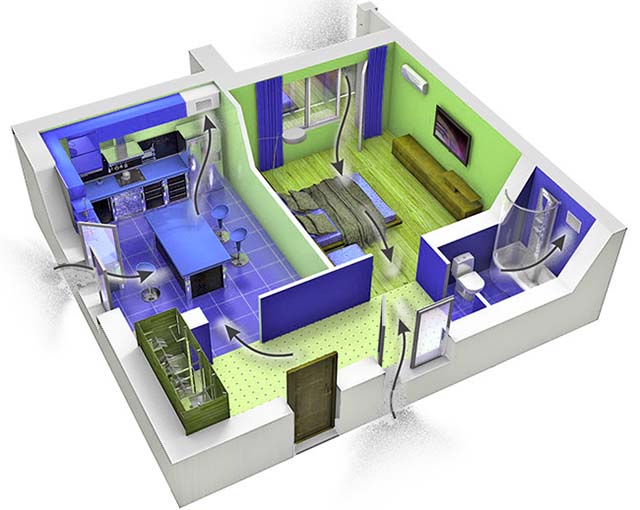

The movement of air currents around the house during the ventilation process
Important! Do not confuse general ventilation with home ventilation. The air flow coming in through open windows is too great and is altered by gusts of wind. A cooler should not and cannot normally condition a room where an uncontrolled volume of outside air flows freely.
Pr = k · A · ∆T [Watt], where
- k [W / m2 K] is the heat transfer coefficient.
- A [m2] is the effective area of the electrical cabinet.
- ∆T [K] is the temperature difference between the air inside and outside the cabinet.
Heat transfer coefficient
- radiation power per 1 m2 of surface area. It is constant and depends on the material:
| Material | Heat transfer coefficient |
| Sheet steel | 5.5 W / m2 K |
| Stainless steel | 5.5 W / m2 K |
| Aluminum | 12.0 W / m2 K |
| Plastic | 3.5 W / m2 K |
Effective surface area of the control cabinet
measured in accordance with VDE 0660 Part 500. The calculation depends on the enclosure position:
| One cabinet free-standing A = 1.8 H (W + D) + 1.4 W D |
| One wall-mounted cabinet A = 1.4 W (H + D) + 1.8 D H |
| End cabinet of free-standing row A = 1.4 D (H + W) + 1.8 W H |
| End cabinet in wall-mounted row A = 1.4 H (W + D) + 1.4 W D |
| Free-standing row not end cabinet A = 1.8 W H + 1.4 W D + D H |
| Non-edge cabinet in wall-mounted row A = 1.4 W (H + D) + D H |
| Non-edge cabinet in a wall-mounted row under a canopy A = 1.4 W H + 0.7 W D + D H |
Where W
- cabinet width,
H
- cabinet height,
D
- the depth of the cabinet, measured in meters.
The temperature difference between the air inside and outside the cabinet is usually measured in degrees Kelvin (the temperature difference in Kelvin is equal to the temperature difference in Celsius).
The difference is found by subtracting the ambient temperature from the temperature inside the cabinet:
Selecting an air conditioner by power
Split systems and cooling units of other types are produced in the form of model lines with products of standard performance - 2.1, 2.6, 3.5 kW and so on. Some manufacturers indicate the power of models in thousands of British Thermal Units (kBTU) - 07, 09, 12, 18, etc. Correspondence of air conditioning units, expressed in kilowatts and BTU, is shown in the table.
Reference. From the designations in kBTU went the popular names of cooling units of different cold, "nine" and others.
Knowing the required performance in kilowatts and imperial units, select a split system in accordance with the recommendations:
- The optimum power of the household air conditioner is in the range of -5 ... + 15% of the calculated value.
- It is better to give a small margin and round the result upwards - to the nearest product in the model range.
- If the calculated cooling capacity exceeds the capacity of the standard cooler by a hundredth of a kilowatt, you should not round up.
Example. The result of calculations is 2.13 kW, the first model in the series develops a cooling capacity of 2.1 kW, the second - 2.6 kW. We choose option No. 1 - a 2.1 kW air conditioner, which corresponds to 7 kBTU.


Example two. In the previous section, we calculated the performance of the unit for a studio apartment - 3.08 kW and fell between the 2.6-3.5 kW modifications. We choose a split-system with a higher capacity (3.5 kW or 12 kBTU), since the rollback to a lower one will not keep within 5%.
For reference. Please note that the power consumption of any air conditioner is three times less than its cooling capacity. The 3.5 kW unit will "pull" about 1200 W of electricity from the network in maximum mode. The reason lies in the principle of operation of the refrigerating machine - "split" does not generate cold, but transfers heat to the street.
The vast majority of climate systems are capable of operating in 2 modes - cooling and heating during the cold season. Moreover, the heat efficiency is higher, since the compressor motor, which consumes electricity, additionally heats the freon circuit. The power difference in cooling and heating mode is shown in the table above.
What power should you focus on
In the technical documentation for air conditioners, two or three types of power are indicated. The indicators characterize different operating parameters: cooling and heating capacity, as well as the electrical power consumed by the split system.
The scattering of metrics can be misleading. In electrical heating devices, such as a boiler or radiator, the heat output corresponds to the energy consumed. For an air conditioner, these parameters are different.
A split-complex, unlike a heater, does not directly convert electricity, but uses it to operate a heat pump. The latter is capable of pumping heat energy much more than the consumed electrical power.
The cooling capacity is indicated in kW, the range of values for household equipment is 2-8 kW. In addition, many manufacturers use the British BTU mark in their datasheets.
The cooling capacity of the split must be suitable for the service conditions. Otherwise, normalization of the microclimate to the specified temperature will become an overwhelming task for the air conditioner and will disable the equipment. Two scenarios are possible:
- low productivity - the operation of the unit is on the verge of possibilities;
- excess power - an increase in the number of on / off switches, which has a detrimental effect on the electric motor.
The ability to heat the room characterizes the heat transfer capacity of the split. The heat output is always slightly higher than the cooling capacity. The difference between the indicators is the ratio of heat loss on the freon pumping route in cooling and heating modes.
The thermal power indicator is especially relevant if the air conditioner is planned to be used as an off-season heating source. A split-complex is many times more efficient than an electric heater.

